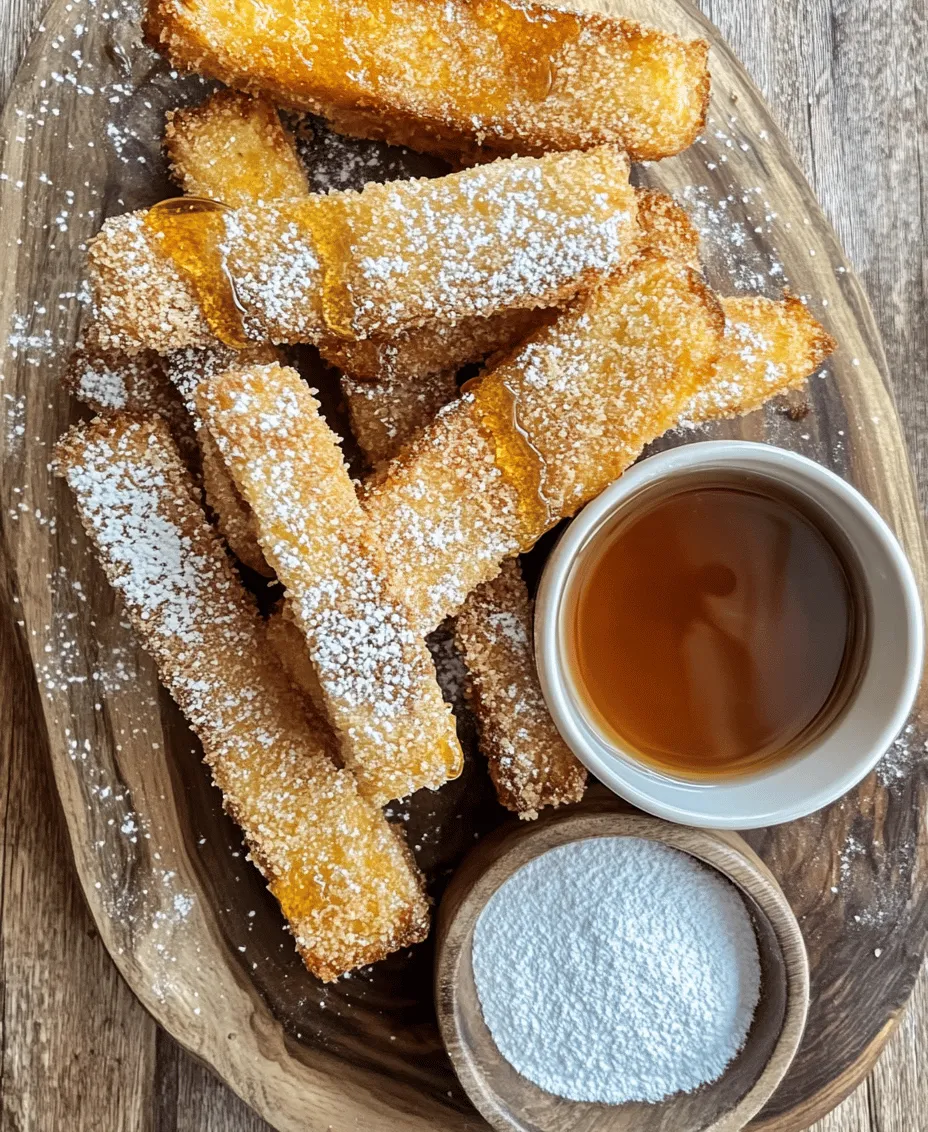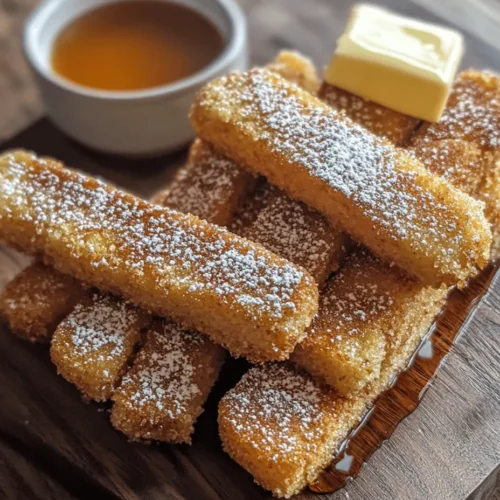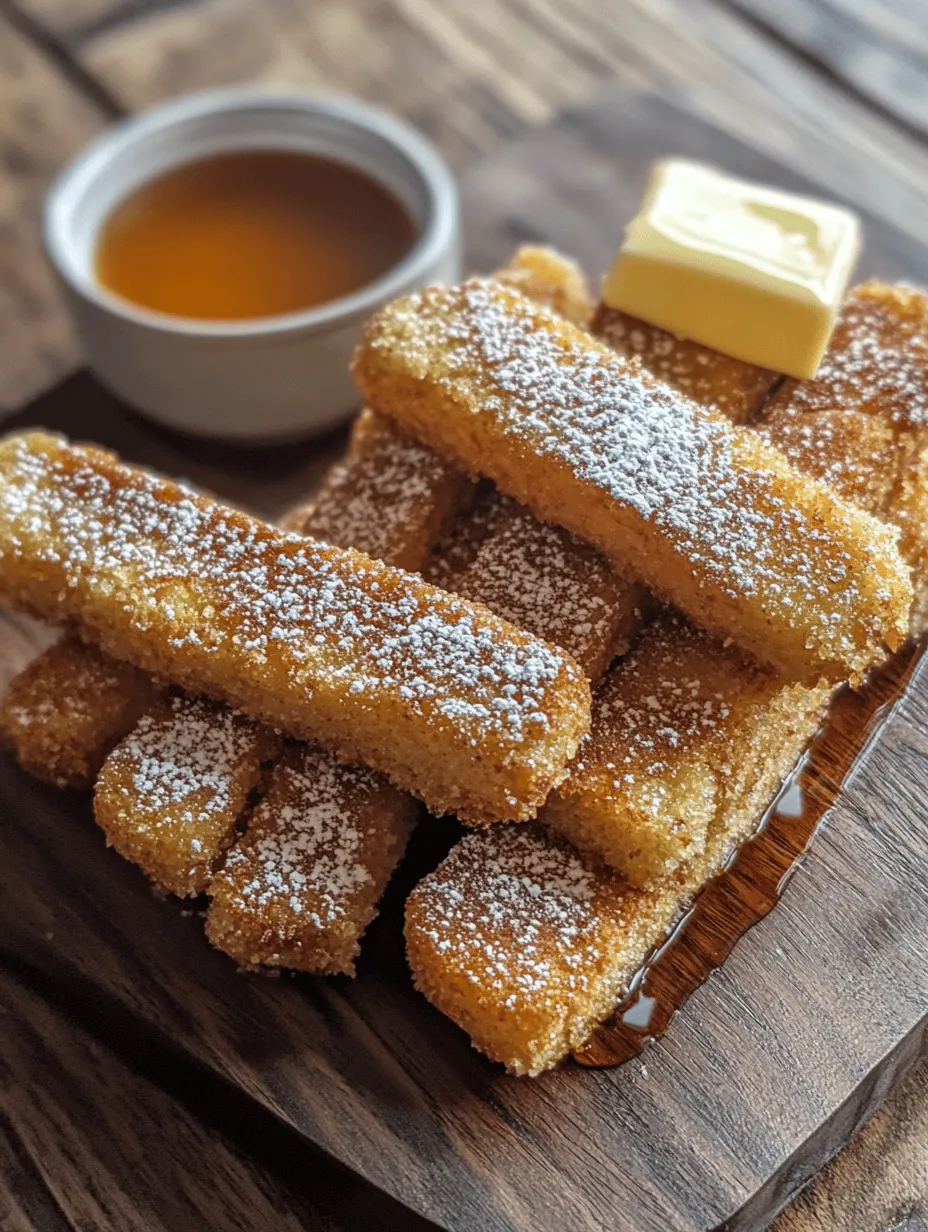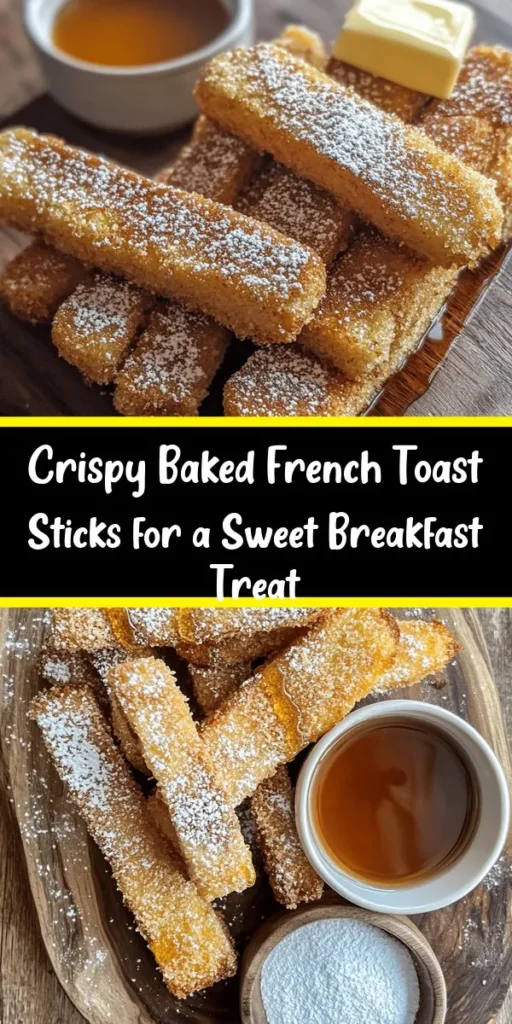Introduction to Deliciously Crunchy Baked French Toast Sticks
Breakfast is often hailed as the most important meal of the day, and for good reason. It sets the tone for the hours ahead, fueling our bodies and minds with the energy we need. If you’re looking to elevate your breakfast game, look no further than this easy-to-follow recipe for Deliciously Crunchy Baked French Toast Sticks.
Imagine golden, crispy sticks of bread, dipped in a flavorful egg mixture and baked to perfection. Not only do these French toast sticks offer a delicious alternative to the classic fried version, but they also provide a healthier option that doesn’t skimp on flavor. The simplicity of the ingredients makes this recipe accessible for busy mornings, yet it’s elegant enough for leisurely weekend brunches with family and friends.
In this article, you’ll discover how everyday ingredients can come together to create a delightful dish that’s both satisfying and fun to eat. The versatility of French toast sticks means they can be enjoyed plain, or dressed up with a variety of toppings and dips, making them a favorite among both kids and adults alike.
Understanding the Appeal of French Toast Sticks
French toast sticks have surged in popularity in recent years, and it’s easy to see why. They blend the rich, comforting flavors of traditional French toast with the convenience of a finger food, making them perfect for a quick breakfast or a relaxed brunch. These portable treats are not only visually appealing, but they also invite creativity in how they are served.
One of the standout features of French toast sticks is their ease of preparation. Unlike making individual slices of French toast, which can be time-consuming, these sticks are baked in a single batch, allowing you to feed a crowd without the fuss. Simply cut the bread, dip it in the custard mixture, and let the oven do the work.
The adaptability of French toast sticks is another reason for their widespread appeal. You can customize them according to your taste preferences or dietary needs, incorporating various dips and toppings. From maple syrup and powdered sugar to fresh fruits and whipped cream, the options are endless. This ability to personalize each serving ensures that everyone at the table finds something they love, making French toast sticks a hit in many households.
Ingredients Breakdown for the Perfect French Toast Sticks
To achieve the best flavor and texture in your Deliciously Crunchy Baked French Toast Sticks, it’s essential to select the right ingredients. Here’s a detailed breakdown of each component that makes this dish so special:
Thick Bread Options: The Importance of Choosing Challah or Brioche
The bread is the foundation of any French toast recipe, and for our baked French toast sticks, thick, enriched breads work best. Challah and brioche are excellent choices due to their rich flavor and soft texture. Challah, a traditional Jewish bread, is slightly sweet and has a beautiful braided appearance, while brioche is a buttery French bread known for its tender crumb.
Using thick slices of these breads ensures that they can soak up the custard mixture without falling apart. Additionally, the richness of challah or brioche complements the egg and milk mixture, resulting in a decadent flavor profile that elevates the dish beyond ordinary breakfast fare.
The Role of Eggs and Milk in Creating a Rich Custard
Eggs and milk are the stars of the custard mixture that brings our French toast sticks to life. Eggs not only add richness but also provide structure, binding the bread together while giving it that classic French toast custardy texture. The proteins in the eggs coagulate during baking, helping to create a soft, tender interior.
Milk contributes creaminess and moisture to the mix. Whole milk is often preferred for its richness, but you can also use alternatives such as almond milk or oat milk for a dairy-free version. The combination of eggs and milk is essential for achieving that perfect custard consistency, allowing the bread to absorb the flavors while maintaining its integrity once baked.
Flavor Enhancers: Vanilla Extract, Cinnamon, and Nutmeg
To elevate our French toast sticks, we’ll incorporate flavor enhancers like vanilla extract, cinnamon, and nutmeg. Vanilla extract adds a warm, aromatic sweetness that pairs beautifully with the bread and custard. It’s a staple in many dessert recipes, but it also serves as a fantastic flavor base for breakfast dishes.
Cinnamon and nutmeg not only enhance the taste but also evoke a sense of comfort and nostalgia, making each bite feel like a warm hug. Cinnamon is a classic spice used in many breakfast recipes, and its sweet, warm notes are complemented by the subtle earthiness of nutmeg, creating a well-rounded flavor profile that defines the essence of French toast.
The Crunch Factor: Panko Breadcrumbs vs. Traditional Breadcrumbs
For that coveted crunch, we’ll be using panko breadcrumbs instead of traditional breadcrumbs. Panko, a Japanese-style breadcrumb, is coarser and lighter than its traditional counterpart. This unique texture allows for a crispier and more airy coating when baked, which perfectly contrasts with the soft, custardy interior of the French toast sticks.
Using panko breadcrumbs ensures that each bite is satisfying and crunchy, adding an exciting textural element to the dish. If you prefer a less crunchy exterior, traditional breadcrumbs can still work, but for the ultimate crunch factor, panko is the way to go.
Step-by-Step Instructions for Baking French Toast Sticks
Now that we’ve covered the ingredients, let’s dive into the step-by-step process for preparing and baking these Deliciously Crunchy Baked French Toast Sticks. Follow these instructions carefully for the best results:
Prepping Your Oven and Baking Sheet: Setting Up for Success
Before you start mixing your ingredients, it’s important to prepare your workspace. Preheat your oven to 375°F (190°C) to ensure even cooking. While the oven is heating, line a baking sheet with parchment paper. This not only prevents the French toast sticks from sticking but also allows for easy cleanup after baking.
Parchment paper acts as a barrier between the bread and the hot baking sheet, helping to crisp up the bottoms without burning. It’s a small but crucial step that sets you up for success as you move forward with the recipe.
Cutting the Bread: Achieving the Perfect Stick Size
Next, it’s time to cut your chosen bread into sticks. For optimal results, aim for pieces that are about 1 inch wide and 4-5 inches long. This size allows for even cooking and provides a satisfying bite. Use a serrated knife for a clean cut, as this will help prevent the bread from squishing.
Once cut, arrange the bread sticks on a clean surface and set them aside. The size and shape of your bread sticks will affect how well they soak up the custard, making this step essential for achieving the right texture and flavor in your final product.
By following these steps, you’re well on your way to creating deliciously crunchy baked French toast sticks that everyone will love. Stay tuned as we continue with the remaining steps and tips for perfecting this delightful breakfast treat.

Creating the Egg Mixture: Tips for Whisking to Perfection
The foundation of any great French toast is a well-prepared egg mixture, which serves as the custard base that infuses the bread with flavor and a creamy texture. To achieve this, start with fresh eggs, as their quality directly influences the taste of your dish. Use a whisk or a fork to beat the eggs thoroughly until the yolks and whites are completely combined. This step is crucial; a uniform mixture ensures that every piece of bread is coated evenly.
For added flavor and richness, incorporate whole milk or almond milk into your egg mixture. A standard ratio is one cup of milk to two large eggs, but feel free to adjust based on your desired creaminess. Add a splash of vanilla extract or a sprinkle of cinnamon to elevate the flavor profile. When whisking, aim for a smooth consistency with no lumps, as uneven mixtures can lead to patchy coatings on the bread. If you’re looking for a slightly sweeter custard, consider adding a tablespoon of sugar or a natural sweetener like maple syrup to the egg mix, balancing flavor without overwhelming the dish.
Dipping and Coating: Mastering the Technique
Once your egg mixture is ready, it’s time to prepare the bread for dipping. Choose your bread wisely; thicker slices of brioche, challah, or Texas toast work best for French toast sticks, as they hold up well during the dipping process and provide a satisfying crunch when baked. Cut the bread into uniform sticks, roughly one inch wide and four inches long, ensuring even cooking throughout.
To dip the bread, first, lay out a baking sheet lined with parchment paper for easy cleanup. Next, take a slice of bread and immerse it in the egg mixture, allowing it to soak for just a few seconds—about 5 seconds per side. The goal is to saturate the bread without making it too soggy, which could affect the final texture. After dipping, let any excess egg mixture drip off before transferring the bread to the coating station.
For the coating, combine breadcrumbs with cinnamon and a pinch of salt in a shallow bowl. You can also use crushed cornflakes or panko for an extra crunchy finish. Gently roll each dipped stick in the breadcrumb mixture, ensuring an even coating. This step is essential for achieving that satisfying crunch that makes these baked French toast sticks so delightful. Place the coated sticks back on the lined baking sheet, ready for their time in the oven.
Baking to Golden Perfection: Timing and Temperature
Baking is a healthier alternative to frying, and it allows for even cooking without the need for excessive oil. Preheat your oven to 375°F (190°C) to create a hot environment that will crisp the outside of the French toast sticks while keeping the inside soft and fluffy.
Once your oven reaches the desired temperature, place the baking sheet in the center rack. Bake the French toast sticks for about 15-20 minutes, turning them halfway through to ensure even browning. Keep an eye on them during the last few minutes of baking; you are aiming for a beautiful golden brown finish. The perfect baked French toast sticks should be crispy on the outside yet tender and flavorful on the inside. If you prefer an extra crunch, broil them for an additional 1-2 minutes after baking, but watch closely to prevent burning.
Serving Suggestions for French Toast Sticks
Now that you’ve mastered the art of creating deliciously crunchy baked French toast sticks, it’s time to enjoy them! These versatile sticks can be paired with various accompaniments, enhancing the overall dining experience.
Tasty Dipping Sauces: From Classic Maple Syrup to Unique Flavors
A classic choice for serving French toast sticks is the ever-popular maple syrup, but don’t hesitate to explore other delicious dipping sauces. Chocolate sauce provides a decadent treat, while fresh fruit compote adds a refreshing twist. For a healthier option, consider serving Greek yogurt mixed with honey or a fruit puree. These sauces not only enhance the flavor of the sticks but also add a layer of fun to the dining experience, especially for kids.
Garnishes to Elevate Your Presentation
Presentation matters, especially when serving breakfast to family or guests. Simple garnishes can elevate the look of your French toast sticks. A handful of fresh berries, such as strawberries, blueberries, or raspberries, adds a burst of color and freshness. A sprig of mint can also brighten the plate and provide a refreshing aroma. Dusting the sticks lightly with powdered sugar before serving creates an inviting and aesthetically pleasing dish.
Nutritional Benefits of Baked French Toast Sticks
When preparing breakfast, it’s essential to consider the nutritional aspects of your meal. Baked French toast sticks offer several benefits compared to their fried counterparts.
Healthier Cooking Method: Why Baking is Better
Baking significantly reduces the amount of fat used in cooking, which is a primary advantage over frying. While frying necessitates oil, baking allows you to achieve a crispy texture without excess grease, making your breakfast healthier. Additionally, baked French toast sticks are easier to prepare, requiring less hands-on time and attention.
Balancing Indulgence with Nutritious Ingredients
By choosing whole or almond milk and limiting added sugars, you can make these French toast sticks more nutritious. Whole milk provides essential nutrients like calcium and vitamin D, while almond milk is lower in calories and fat. Opting for natural sweeteners and whole-grain bread can further enhance the fiber content of your breakfast, contributing to a balanced meal that satisfies without compromising health.
Conclusion: Enjoying the Perfect Breakfast Experience
Deliciously Crunchy Baked French Toast Sticks are not just a meal; they are an experience. This recipe embodies the joy of cooking and sharing delightful food with loved ones. The simplicity of the preparation, combined with the versatility of flavors and toppings, makes this dish a staple in any breakfast repertoire.
Encourage your family and friends to personalize their French toast sticks with their favorite flavors and toppings. Whether they prefer classic maple syrup or a creative fruit compote, the possibilities are endless. As you gather around the table, savor the moments spent enjoying these crispy delights and the laughter shared over breakfast. With each bite, you’re not just indulging in a delicious meal; you’re creating memories that will be cherished long after the last stick is gone.



